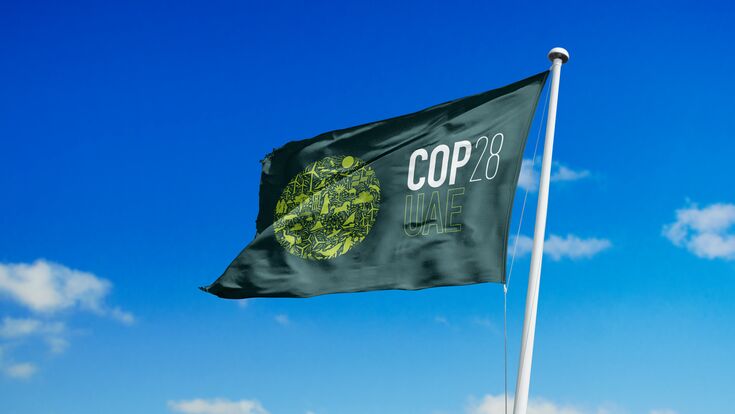December 2023
By Mike Aquino, director, ESG, International Dairy Foods Association
Each time a Conference of the Parties (COP) is convened, a diverse group of stakeholders from around the world comes together to discuss approaches to global climate management. These conferences are large undertakings. COP28, which just came to a close in Dubai, hosted approximately 85,000 people. Whether your organization was in attendance or not, keeping track of all the COP news coverage, criticism and commitments can be overwhelming. Below, I’ve outlined my key takeaways from this year’s COP for IDFA members and all our dairy industry stakeholders.
One Big Request
Put a dairy farmer at the top of COP
The global dairy sector is uniquely positioned to efficiently deliver much needed nutrition while also contributing to climate change mitigation advancements. We aren’t naïve about our environmental impacts. Instead, we continue to collaborate and improve our management of those impacts. Dairy cow power—renewable energy from anaerobic digestion of manure—already provides one avenue of assistance for a transition to a less fossil fuel dependent economy. Dairy is actively pursuing multiple avenues of improved methane management. And the global dairy community is actively engaged in building our sector’s capacity to transparently (and consistently) assure our stakeholders that dairy carbon interventions are high-quality and credible. We should not hold back telling our story for fear of criticism. We can embrace critiques to continuously improve. So, agriculture, and specifically dairy, should embrace being front and center when the parties convene again in 2024 (and for the record, dairy’s presence at COP28 was quite impressive).
That is why I propose the President of COP29 be a dairy farmer. Considering the focus on managing the GHG footprint of food production systems, putting a farmer—and a dairy farmer, specifically—at the top of COP would bring more authentic voices of farming, forestry, and other natural carbon sinks to the COP table to lead and participate in consequential discussions. Often, farmers, producers and growers are an afterthought in such global gatherings reserved for wealthy foundation and think tank leaders, vocal NGOs, and plane loads of bureaucrats. Putting a dairy farmer at the top of COP would show the world that food producers are committed to science-based solutions for food systems innovation while continuing to decarbonize their value chains.
Three Big Things for Dairy
A historic acknowledgment about fossil fuels and climate.
While critics will find some low-hanging fruit, like the lack of “teeth” related to the agreement achieved at COP28, this outcome will likely be observed by many as an historic step in the right direction. Essentially, negotiations resulted in a commitment to transition the world’s energy systems away from fossil fuels. Informed by prevailing climate science, this commitment appears to strike a pragmatic balance between our collective need to decarbonize and the many trade-offs associated with energy economics.
I think the global dairy community can view this high-level, multilateral commitment as complementary to efforts already happening along dairy foods supply chains. For instance, in the United States there are over 350 active bio-digestion projects with feedstocks from dairy farming. These manure-fed systems deliver multiple pathways to renewable energy, including the production of renewable natural gas to replace fossil-derived transportation fuels in western states with low carbon fuel standard (LCFS) policies.[1] The dairy sector is also embracing wind and solar energy, both on farms and to power our manufacturing facilities. We expect this momentum to continue, fueled in part by significant Inflation Reduction Act incentives. The point: dairy is part of the solution as nations plan a reasonable transition to a more diverse, lower-carbon energy system as agreed upon at COP.
A focus on methane
IDFA applauds our members and the Environmental Defense Fund (EDF) for their launch of the Dairy Methane Action Alliance (DMAA) at COP28. This commitment complements the great research, investment and momentum already at play as the global dairy sector aims to manage greenhouse gas (GHG) emissions, such as the Greener Cattle Initiative. Dairy’s advanced manure management systems and pipeline of promising technological advances to address enteric methane should only grow in adoption with more and more dairy processing interests (customers) explicitly calling attention to—and setting reduction commitments for—methane.
Kicking the can on offsetting specifics
Multilateral conversations can and do drag on for years. My third takeaway from this year’s COP was a notable lack of progress on implementation details related to GHG offsetting. This topic is addressed in Article 6 of the 2015 Paris agreements. Article 6 covers details about validating high-quality carbon credits and how those credits may be exchanged between nations as part of their climate action strategies.
The ongoing discussions on the international stage surrounding carbon crediting systems are important for dairy stakeholders to monitor. Ultimately, it is anticipated that at least some aspects of Article 6 details will inform best practices and help establish norms in environmental attribute marketplaces more broadly, including both regulatory and voluntary carbon markets. As a signal of the topic’s relevance, both the U.S. Department of Agriculture (USDA) and the Commodity Futures Trading Commission (CFTC) have recently issued a report and guidance related to voluntary carbon markets (VCMs). Many agricultural commodity interests, including dairy, see opportunities for participation in carbon markets. Our sector is already moving on further development of best practices and technology solutions for measuring, monitoring, reporting and verification (MMRV) of the high-quality carbon reductions and removals that can be delivered by agricultural operations in anticipation of future opportunities for credit generation (whether such credits are sold to other industries, nations, or kept within agriculture value chains). Dairy stakeholders are engaged in multiple working groups on this topic, including participation with the Value Change Initiative and the SAI Platform Sustainable Dairy Partnership. IDFA will continue to monitor developments of guidance and standards related to carbon marketplaces, and we look forward Article 6 progress at COP29 (Azerbaijan) and COP30 (Brazil).
If you’re interested in reading more about COP28, I recommend this press release from Ceres along with this recent blog post by McKinsey & Company.
What is a COP?
“COP” stands for Conference of the Parties, and is the annual convening of the nearly 200 countries that have ratified the United Nations Framework Convention on Climate Change (UNFCCC, 1994). Now in its 28th year, the COP summit is the world’s primary forum for multilateral climate change action planning and associated negotiations. Notably, perhaps the two most well-known international climate-related agreements of recent history, Kyoto and Paris, were outcomes of COP3 and COP21, respectively. Since climate change mitigation and adaptation efforts require collective action beyond the control of any single government, the UNFCCC approach to climate management is vitally important for establishing governance norms and maintaining climate action momentum at a global scale. Of course, governments alone will not overcome the many complex challenges of climate stewardship, so COP is also a forum for information sharing and negotiations with industrial interests and civil society at large.
Are COPs useful?
It strikes me that global climate action is very incremental by nature, not unlike other complex collective action problems. So, it seems natural and fair to wonder, “is the whole COP thing one big boondoggle?” To that, my answer is no. COPs are not fruitless endeavors. COP events typically serve society by providing a forum for, at least, knowledge sharing, activism, and goal setting. Together, this forum helps us progress as civil society shares priority concerns with governments and the global business community. Even if multilateral agreements and commitments may sometimes lack clear paths for implementation (and/or clear mechanisms of enforcement), the public nature of COP outcomes inevitably serves to signal markets and national politicians. This should increase accountability and voluntary action overall. With this in mind, COP outcomes (including topics that don’t advance much) are worth paying attention to, even if we view them with a healthy dose of skepticism. COP outcomes may indeed end up affecting our businesses as global issue awareness diffuses into regulatory developments and consumer trends.
IDFA members with questions and concerns should reach out to me at maquino@idfa.org or IDFA Vice President of Regulatory Affairs & Counsel, Danielle Quist, at dquist@idfa.org.
IDFA Staff Expert

Mike Aquino
Director, ESG
[1] References: https://www.epa.gov/agstar; https://ww2.arb.ca.gov/resources/documents/lcfs-pathway-certified-carbon-intensities

